Reduced-dose radiation in human papillomavirus-associated oropharyngeal carcinoma can improve outcome: a systematic review and meta-analysis
- PMID: 36660712
- PMCID: PMC9843369
- DOI: 10.21037/atm-22-5935
Reduced-dose radiation in human papillomavirus-associated oropharyngeal carcinoma can improve outcome: a systematic review and meta-analysis
Abstract
Background: Despite its effectiveness, the standard course of chemoradiation for the treatment of human papillomavirus (HPV)-related oropharyngeal carcinoma (OPC) results in considerable treatment-related adverse effects. Studies proved that HPV-positive OPC is very sensitive to radiotherapy. Using de-escalation therapy as a new strategy is critical to maintaining positive outcomes while alleviating side effects. However, some studies hold that reduced dose causes insufficient effect on tumor killing. We conducted this systematic review and meta-analysis of survival and adverse reactions in patients with HPV-related OPC by retrospective analysis and evaluated the therapeutic effect of reducing the radiation dose.
Methods: Data were double-selected and extracted by searching seven electronic databases, Original studies in all language treated HPV-associated OPC with reduced-dose and standard-dose therapies were included. Overall survival (OS), progression-free survival (PFS), and incidence rates of adverse events were obtained by pooling analyses. Statistical analyses were performed using RStudio Version 1.1.383 (RStudio, Boston, MA, USA) via the Meta-Analysis R Package (metafor). Heterogeneity was evaluated using the I2 statistic and the Cochran Q test. We used Stata (version 15.0) for forest graph.
Results: Thirteen studies were included in this meta-analysis, involving a dose range of 66-70 Gy for the standard treatment regimen and <66 Gy for the reduced-dose group. There was no significant difference in the age of the patients in the standard and the reduced treatment groups (60.9±5.9 vs. 58.6±2.4 years). Nine studies were included as standard cohort and thirteen studies were enrolled as reduced-dose cohort. The 2- and 3-year overall survival rates in the reduced-dose group (95.66% and 91.51%, respectively) were superior to those in the standard-dose group (88.36% and 87.46%, respectively). There was no significant difference in PFS between the two groups. A systematic review of articles on dose reduction and the standard dose was also conducted. The most common complication in reduced-dose radiation was oral mucositis (36.4%), followed by decreased white blood cell (WBC) count (30.5%) and dry mouth (29.1%).
Conclusions: Reducing the radiation dose in patients with HPV-related OPC substantially alleviates the treatment toxicities and optimizes the quality of life of patients while at the same time maintaining favorable oncologic outcomes.
Keywords: Human papillomavirus (HPV)-related; oropharyngeal cancer; radiotherapy; reduced dose.
2022 Annals of Translational Medicine. All rights reserved.
Conflict of interest statement
Conflicts of Interest: All authors have completed the ICMJE uniform disclosure form (available at https://atm.amegroups.com/article/view/10.21037/atm-22-5935/coif). JDS reports that the current study was supported by grants from the National Natural Science Foundation of China (No. 81802740), and the Chongqing Science and Health Joint Medical Research Project (No. 2022ZDXM028). YW reports that the current study was supported by grants from the National Natural Science Foundation of China (No. 81972857), and the Natural Science Foundation of Chongqing City (No. cstc2021jscx-msxm0029). The other authors have no conflicts of interest to declare.
Figures



Similar articles
-
De-intensification of therapy in human papillomavirus associated oropharyngeal cancer: A systematic review of prospective trials.Oral Oncol. 2020 Apr;103:104608. doi: 10.1016/j.oraloncology.2020.104608. Epub 2020 Mar 9. Oral Oncol. 2020. PMID: 32163853
-
Evaluation of Substantial Reduction in Elective Radiotherapy Dose and Field in Patients With Human Papillomavirus-Associated Oropharyngeal Carcinoma Treated With Definitive Chemoradiotherapy.JAMA Oncol. 2022 Mar 1;8(3):364-372. doi: 10.1001/jamaoncol.2021.6416. JAMA Oncol. 2022. PMID: 35050342 Free PMC article.
-
Toxicity Profiles and Survival Outcomes Among Patients With Nonmetastatic Oropharyngeal Carcinoma Treated With Intensity-Modulated Proton Therapy vs Intensity-Modulated Radiation Therapy.JAMA Netw Open. 2022 Nov 1;5(11):e2241538. doi: 10.1001/jamanetworkopen.2022.41538. JAMA Netw Open. 2022. PMID: 36367724 Free PMC article.
-
Prognostic Implication of Persistent Human Papillomavirus Type 16 DNA Detection in Oral Rinses for Human Papillomavirus-Related Oropharyngeal Carcinoma.JAMA Oncol. 2015 Oct;1(7):907-15. doi: 10.1001/jamaoncol.2015.2524. JAMA Oncol. 2015. PMID: 26226294 Free PMC article.
-
De-escalation in HPV-associated oropharyngeal cancer: lessons learned from the past? A critical viewpoint and proposal for future research.Eur Arch Otorhinolaryngol. 2021 Nov;278(11):4599-4603. doi: 10.1007/s00405-021-06686-9. Epub 2021 Feb 18. Eur Arch Otorhinolaryngol. 2021. PMID: 33599841 Review.
Cited by
-
Etiology, diagnosis, treatment, and prevention of human papilloma virus-associated oropharyngeal squamous cell carcinoma.Int J Clin Oncol. 2023 Aug;28(8):975-981. doi: 10.1007/s10147-023-02336-8. Epub 2023 Apr 24. Int J Clin Oncol. 2023. PMID: 37093464 Free PMC article. Review.
-
HPV-driven cancer: from epidemiology to the HPV-driven tumor board proposal, everything you wanted to know but were afraid to ask.Clin Transl Oncol. 2025 Aug;27(8):3511-3529. doi: 10.1007/s12094-025-03868-3. Epub 2025 Mar 6. Clin Transl Oncol. 2025. PMID: 40048019 Review.
-
De-escalated radiation for human papillomavirus virus-related oropharyngeal cancer: evolving paradigms and future strategies.Front Oncol. 2023 Jul 27;13:1175578. doi: 10.3389/fonc.2023.1175578. eCollection 2023. Front Oncol. 2023. PMID: 37576899 Free PMC article. Review.
-
Association of Gene Expression Profiles in HPV-Positive Head and Neck Squamous Cell Carcinoma with Patient Outcome: In Search of Prognostic Biomarkers.Int J Mol Sci. 2025 Jun 19;26(12):5894. doi: 10.3390/ijms26125894. Int J Mol Sci. 2025. PMID: 40565370 Free PMC article.
References
LinkOut - more resources
Full Text Sources
